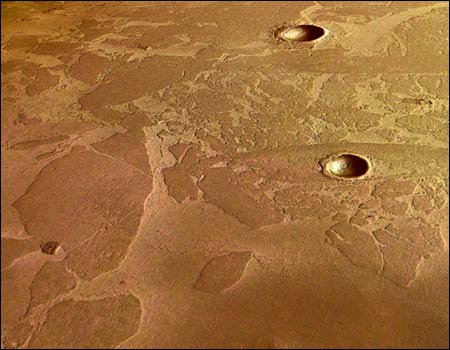A probe of the European Space Agency transmitted photos showing the frozen sea, near the equator of the Red Planet

The European Mars Express spacecraft, which has been orbiting Mars for about a year, has discovered what scientists say looks like a large frozen sea near the Martian equator. The discovery is the first of a large body of water other than the glaciers in the ice caps of Mars' poles.
Although the high-resolution images cover an area of only a few tens of kilometers, they captured what appears to be a flood plain 800 by 900 kilometers in area. The area is covered in volcanic ash, according to the European Space Agency.
The image published on the European Space Agency website shows a plain covered in irregular brick-like shapes.
"They look like ice barges floating to the shores of Antarctica." written on the site.
It was also reported that the water that created the sea rose underground and created a catastrophic flood at a depth of 45 meters. The European Space Agency says that when the water froze, it broke up into blocks that were covered with an insulated layer of volcanic ash.
"Ice is an unstable factor on the surface of Mars due to the low air pressure that causes the ice to rise and mix in the atmosphere (go almost directly from a solid state to a gas and skip the liquid state of aggregation), however some of the ice blocks were preserved thanks to the protection of the volcanic ash. The unprotected parts simply evaporated and the bedrock was exposed again.
It was also reported that the presence of craters in the plain was revealed and therefore it seems that this sea is relatively fresh, it was formed 5 million years ago in total.
"The observations show that the ice is still there. First, the craters are relatively shallow and this shows that most of the ice is still in the craters. And secondly, the surface is too flat. ESA experts added."
The European Space Agency plans to land a spacecraft on Mars within five years.
The discovery of a large reservoir of water, together with the oxygen they contain, is like gold dust for space flight planners. They could serve as a factor that would facilitate the manned flights to Mars.
The image taken by the high-resolution stereoscopic camera aboard the Mars Express spacecraft shows a frozen dust-covered sea near the equatorial equator. It shows a flat plain, part of Elysium Planitia interwoven with blocks of irregular shapes. The area has a diameter of several tens of kilometers and its center is at longitude 5º north and longitude 150º west.
